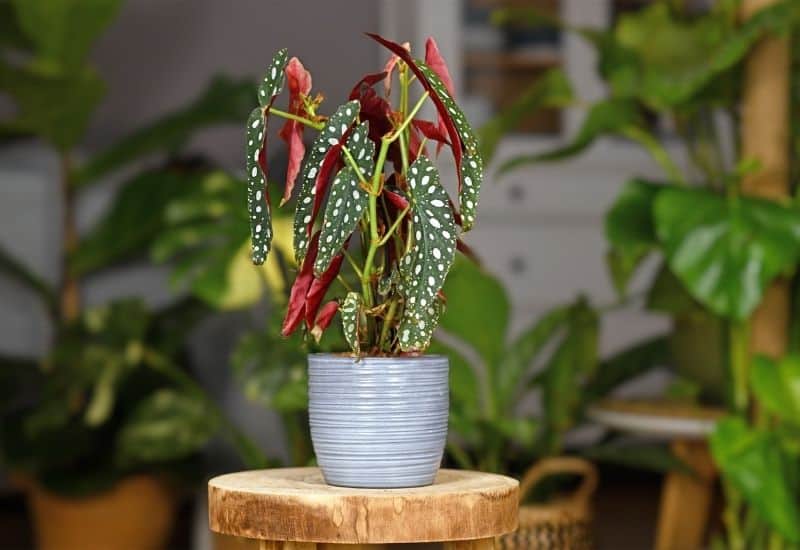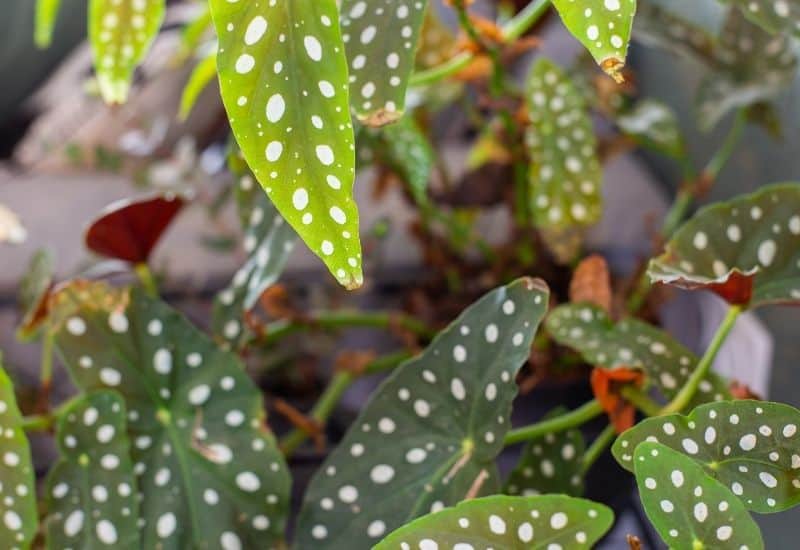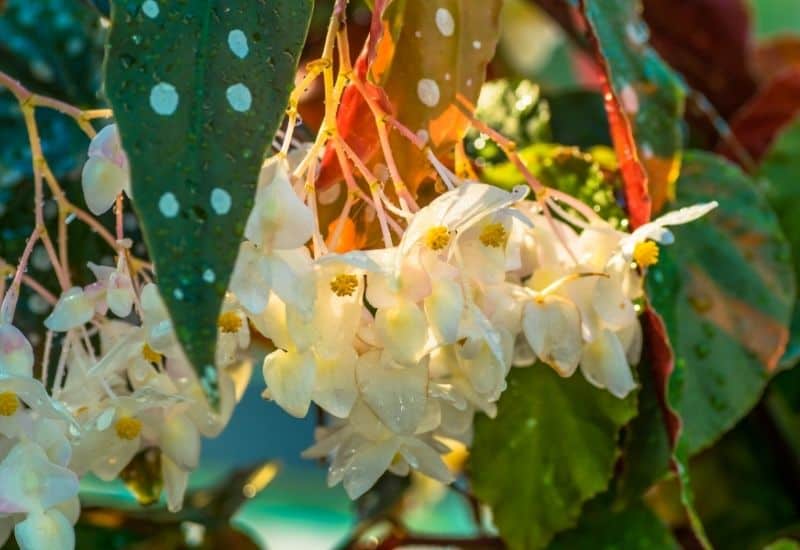Begonias are a beautiful flower that is popular in gardens and terrariums. This plant can be used as a ground cover or in containers with other plants. Growing begonias indoors requires a little more attention than most houseplants, but it’s worth the effort! In this article, we will discuss how to care for your Begonia Maculata.
Begonia Maculata Care Guide Overview
- How To Plant (when & where)
- How To Grow (staking, watering, fertilizing, humidity, mulching)
- How To Trim And Prune
- How To Pot And Repot
- How To Propagate (when & how)
- And Pests and Diseases, Plant Species, Companions, Toxicity
Characteristics
- Scientific name and common names: Begonia Maculata, Spotted-Leaf Begonia, Painted Lady Begonia.
- Origin: Africa
- Indoor or Outdoor Plant: Outdoor (cold hardiness zone: USDA 8 and above)
- Height and structure: Up to 2 feet tall, upright-spreading to twining stems
- Temperature: Indoors 65-90 degrees Fahrenheit, outdoors night temps. not lower than 40 degrees F
- Flower Color: White
How To Plant The Begonia Maculata

Planting time
The best time to plant your Begonia Maculata is in the spring, or when night temperatures are consistently above 50 degrees. You can also grow during summer when nighttime temperatures are above 55 degrees. Keep in mind that it cannot survive frost.
Soil
Begonia Maculata needs well-draining soil, so add some perlite to the potting mix. Make sure you use a pot with drainage holes to allow excess water to flow through, preventing root rot. If you have heavy rainfall in your area or have low spots where water tends to accumulate, you can also add some gravel to the potting mix; this will allow excess moisture to drain through the bottom. You want the soil to be moist but not too wet.
Light
Begonia Maculata can adapt to most light levels, but it will grow faster with good sunlight. If you live in an area where the days are shorter during winter, place your plant near a window so they can get some sun exposure. If you live in a place that gets plenty of sunlight, keep your plant on the brightest side of the house. If it starts to look weak and sickly during winter, move it to a shadier spot, so its leaves don’t droop.
Watering
The soil needs to be moist but not too wet. Make sure you water your plant well and allow excess water to flow through the bottom of the pot. The pot must have drainage holes, so you don’t overwater or suffocate the roots. You can mist it with a spray bottle as an alternative to watering. To see if your plant needs water, stick your finger an inch into the soil. If it is dry, water the plant. If it is wet, don’t water until the top layer of soil is completely dry.
How To Grow The Begonia Maculata

Growth habits
Begonia Maculata is a flowering begonia that produces clusters of leaves with colorful jewel-like flowers. It can become invasive; however, it will start to look ill and droopy if it gets too big. If you don’t like this behavior or want to control the spread of your Begonia Maculata, cut off the plant’s growing tips. It should branch out, growing into a bushier plant.
Stacking
Begonia Maculata can be planted together in a way called stacking. This is an easy and pretty way to grow several plants at once. However, it should be noted that stacking should not be used as a replacement for regular pruning but rather as an alternative because it will produce different types of growth from the usual pruning results.
Select several healthy and similar Begonia Maculata plants. This will produce the most symmetrical results. Make sure they each have at least two leaves and that their soil is damp and plump in the center of the plant. Remove any dead or overly wilted leaves from the bottom of the stem if necessary. Start by placing one of the plants in an empty pot. Make sure that there are drainage holes in the bottom of this pot. It is generally best to use pots at least 3 inches larger than the plant because they will need growth room. The top should be just below soil level when you plant the Begonia Maculata into the pot.
Next, stack another plant on top of the one in your pot. The leaves will be on each side of the first plant’s stem. You should cover up the tip of the bottom plant’s stem if possible. Fill in any gaps with soil or moss. There is no need to water it at this time because you have not disturbed its roots.
Place these plants on a windowsill or some other area that gets plenty of sunlight and has good air circulation, such as near a fan. The plants will need about two weeks to adjust to their new pot before growing fresh leaves and roots.
Watering
You should water your Begonia Maculata well, but remember that it doesn’t have any drainage holes, so you need to allow the excess water to flow through. If your pot is sitting in some standing water, empty it, so the roots don’t rot. You should use only water again when the surface of the soil has become completely dry. Too much water is the main reason plants die.
Fertilizing
Fertilizing is not necessary with Begonia Maculata. If you are growing them in a pot, they will not need any extra fertilizing because their soil is already rich. When there are too many nutrients, the plant will start to grow bigger and drop leaves. This is an unhealthy state for your plant if it gets too big because it needs pruning. It would be best if you fertilized other types of begonias, but not this one.
Humidity
Be careful not to overwater your plant. Most indoor plants need a lot of humidity and moisture in the air, and Begonia Maculata is no exception. If you keep it in an area with low humidity or regular exposure to fan or vent covers on cold nights, you will dry out its foliage and possibly kill it over time by drying out its roots too. Make sure it is potted in soil with good drainage or some saucer for excess water.
Mulching
Mulching is when you add a layer of organic matter around the base of your plant. This is a perfect idea for Begonia Maculata because it will give it better soil to grow in and prevent its roots from rotting or becoming too wet. You can use black plastic, mulch, pine needles, bark chips, or any other organic product that you can find. The mulching will help to store moisture, too. When mulching, make sure you don’t cover up the tips of the stems. Be careful not to pile it too high around the plant, or its roots will suffocate and die.
Trimming and pruning
Sufficient pruning is crucial to producing a healthy and lush Begonia Maculata plant. This will also help you shape the plant into the desired form, such as a standard. Trim off excess leaves or stems from the bottom of your plant or any that have been damaged by pests or moisture problems. Make cuts just above a lateral bud. This will help the plant to grow bushier and fuller, which makes it even more attractive. You can also prune off excess stems that do not have any healthy buds.
The first step in pruning is to remove any dead parts of the plant, so you should inspect it every week or two. Dead leaves, stems, buds, and roots are easy to spot because they will be brown. This is also an excellent time to trim off any damaged leaves that are not growing well into healthy new leaves. You can cut back tiny Begonia Maculata plants, but if they have been growing for several months or more, you will need to prune them in the spring instead.
You can add a lot of detail and change the shape of your begonias by carefully trimming them when they are not flowering. It would help if you waited until after they have finished blooming, though, so you don’t affect next season’s flowers.
Pot and Repotting
You should only report Begonia Maculata if its current pot is too small or the plant has been in it for more than a year. Keeping the plant in a large pot will grow faster and become larger, but it won’t produce as many blooms. You should also replace your Begonia Maculata’s soil every year, but only re-pot your plant if it is overcrowded or their roots are visible. You can tell where the roots are because they will be growing out of the drainage holes on the bottom of the pot.
Propagation
There are different ways to propagate Begonia Maculata plants. You can do a stem cutting, a leaf pull, or a division of the plant. You must take your cuttings from healthy plants and make sure they have one node on them. A node is an area between a set of leaves where you will place your cutting to root it.
To propagate Begonia Maculata through a leaf pull, you should dig up the plant and look for several leaflets (leaves) that are joined together at one point on either side of its stem. You can cut these leaflets away from their stem with your sharp knife or pruning shears. Then take all your leaf pulls and root them separately. You can also do this by sticking the leaf pull directly into a small jar of water with some rocks as a weight on top to keep it submerged.
You can divide Begonia Maculata plants by digging up the whole plant and separating it into sections containing its roots. This is best done during the winter. You should check to make sure your plant is entirely healthy before you divide it, or it might not grow properly after you do so. If there are any dead roots, remove them and discard them because they will contaminate your new plants.
Divide and transplant
After your Begonia Maculata plant has been in its same pot for a while, it will slowly get overcrowded, and you will need to divide it. This is best done during the winter when the temperatures are cooler and won’t be damaged by transplanting. Ensure that your plant is healthy before transplanting because if you try to divide a diseased plant, the new plants may die.
Pests and diseases
The most common pests that affect Begonia Maculata are aphids, whiteflies, mealybugs, leaf miners, and spider mites. Spider mites are the most common pest of begonias. You can tell if your plant has them by seeing fine webbing on its leaves or tiny yellow spots on the undersides of its leaves. Aphids are small, green insects that can be found on the undersides of begonias’ leaves. These insects suck the sap from the plant and weaken it.
Whiteflies also cause weak plants because they suck out nutrients and secrete a sticky substance called honeydew onto the leaves. This causes sooty mold to grow, which is a black fungus that discolors the plant. Mealybugs are white or pink insects that also suck sap from plants hidden in leaf joints or underneath leaves. You can see their excrement on the underside of your Begonia Maculata’s leaves.
Because begonias like moist environments, they are susceptible to fungus and bacterial diseases, such as root rot. Root rot is caused by having too much water around your plant’s roots or never allowing the soil to dry out between waterings. You can tell if you have root rot by seeing brown spots at the base of your Begonia Maculata’s leaves.
If your Begonia gets a disease or has pests, the best thing to do is separate it from other plants and reduce the amount of water you give it. Letting the soil dry out completely between watering will also help. If your plant does not respond well to these treatments, re-pot in the fresh ground and start from scratch.
Plant species

Some common species include Begonia semperflorens, Begonia tuberhybrida, and Begonia boliviensis. The Begonia semperflorens species, commonly known as the scarlet Begonia, is a popular ornamental plant used in gardens and containers. The plants grow well indoors year-round and are sometimes referred to as wax begonias or tuberous begonias because of their extensive underground tubers.
They come in a variety of flower colors, including red, pink, and white. They typically grow between three and six inches tall and require moist soil with a neutral ph. The Begonia tuberhybrida species is also known as the fibrous Begonia because its thin roots resemble a succulent plant. It is grown for its colorful leaves rather than its flowers.
It requires bright, indirect sunlight and evenly moist soil. The Begonia boliviensis, commonly known as the Bolivian Begonia, is a small plant that does not grow much higher than six inches tall. It has large flowers that come in shades of pink or yellow.
Companions
Begonias are commonly planted with other tropical plants to create a beautiful display. Some good companion plants include caladiums, dracaena, ginger, and coleus. The caladium plant is often used to brighten up the area around larger begonia plants. Caladium leaves come in shades of green, red, or blue and have a heart-shaped pattern.
Dracaena is also a beautiful leafy plant that can make a great companion to the Begonia Maculata, significantly growing it in an area with low light. The common name for dracaena is “lucky bamboo.” It will grow to be four feet tall and has long, narrow leaves.
Ginger is a great companion plant because it will grow to be about the same height as the Begonia Maculata and has beautiful flowers that attract butterflies. Coleus is another great companion plant for begonias. It grows into a shrub up to three feet tall and has pretty variegated green and purple leaves with light pink flowers. It lends a tropical flair to any garden or container it’s planted with.
Toxicity
The Begonia Maculata is toxic if eaten, either by humans or cats, or dogs. It contains oxalic acid crystals, which irritate the mouth and stomach. If ingested in large enough quantities, these crystals can cause vomiting in your pet. If a cat or dog eats a whole begonia plant that is not removed from their reach, they risk severe poisoning.
Please be sure to keep all begonias out of your pets’ reach when planning where to place them in your home. Also, make sure the soil is dry between watering because even non-toxic plants can become poisonous when overwatered.


